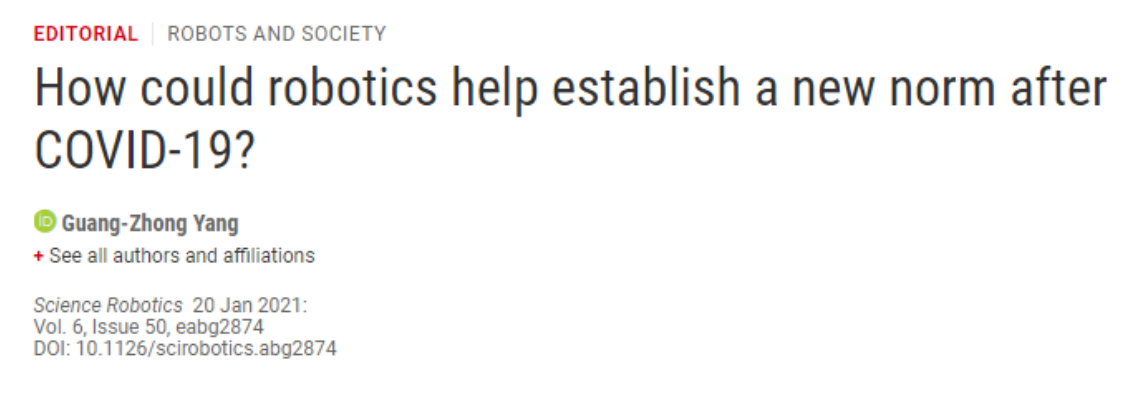


Professor Guang-Zhong Yang published an editorial on “How could Robotics help establish a new norm after COVID-19” in the journal Science Robotics
January 26, 2021

Recently, Professor Guang-Zhong Yang, the Dean of the Institute of Medical Robotics, Shanghai Jiao Tong University, published an editorial entitled "How could Robotics help establish a new norm after COVID-19" in the Journal of Science Robotics. He believes that we should pay attention to the negative impact of the pandemic on the whole society. During and after the COVID-19 pandemic, robotics should build on innovation to help build new norms that provide long-term solutions and fundamental change for businesses, logistics, manufacturing and supply chain management, transportation, healthcare, research, and education.
At the beginning of the COVID-19 pandemic, Science Robotics published an Editorial detailing the views on the role of robotics in managing public health and infectious diseases. It was hoped that by the end of 2020, life and business would return to normal, and the economic situation would rapidly recover. Unfortunately, we still see few signs that the pandemic is relenting. COVID-19 has brought about unprecedented change in our way of life: businesses need to get by with fewer workers, more interruptions, and more travel restrictions; health services must cope with unexpected surges of newly infected patients while managing a backlog of existing patients; schools have to adapt to new approaches to education with hybrid online and classroom teaching, and researchers must find creative ways to conduct laboratory work remotely and to collaborate virtually.
Professor Yang offers many reflections on these changes. What will be the new norms of life and business? Do we have to reactively adapt to unexpected, continued outbreaks? Or will we establish new ways of life that are resilient to the level of interruptions we see for COVID-19, both locally and globally? Will manufacturing go beyond what has been promised by Industry 4.0, with distributed workforces and intelligent human-robot interaction with learning and adaptation? For example, the use of collaborative robots (cobots) to achieve agile manufacturing in factories has been suggested. Cobots would enable existing production lines to be repurposed and allow for remote and flexible working while maintaining social distancing. Will we be able to rapidly expand the capacity of hospitals to handle disasters using service robots? Will our schools continue to adopt new ways of teaching by leveraging digital resources for online learning? Will researchers explore new ways of collaboration and laboratory automation such that remote access and robot-assisted experiments become standard practice? And what about the indirect impacts of the novel coronavirus? Is it possible to use socially assistive robots to ameliorate the negative consequences of social distancing and isolation (e.g., anxiety and depression), as well as to address issues related to physical, cognitive, and mental health and education?
Crises can be drivers for innovation. Looking back on history, we have seen many examples of innovation in times of adversity. In a recent report by McKinsey & Company about innovation in a crisis, the authors concluded that businesses simply cannot operate as they have in the past, because existing business models may no longer be viable during or after the crisis: “Crises, especially the one we are experiencing now, have a significant financial and human toll, stranding assets and human capital and causing significant social and economic dislocation. However, many of these dynamics are ingredients for disruption from which new business models emerge.” The report explains how the sharing economy, which enables users to maximize the utilization of their assets using online marketplaces, stemmed from the confluence of the financial crisis of 2009 and information technology innovations. Other examples include how the SARS epidemic in 2002 led to a broader adoption of e-commerce in Asia and how a recent focus on climate change has driven innovations in plant-based meat substitutes and electric vehicles.
The last Editorial on COVID-19 outlined key opportunities for robotics to be used during major outbreaks or a pandemic, as well as for logistics, reconnaissance, and surveillance. The resurgence of both imported and community-spread infections, exacerbated by new fears of virus mutation with faster transmission rates, has created fears of never-ending cycles of coronavirus infection and its impact on societies. Although COVID-19’s primary impact has hit the global economy hard, it is also important to consider the secondary effects of the pandemic on society as a whole. As 2021 begins, what is certain, unfortunately, is that there is no certainty about when the coronavirus crisis will slow down or end.
Could robotics help establish a new norm during and after COVID-19? Robotics should not aim to just offer immediate fixes; rather, it should set an ambitious goal of long-term solutions and radical change to business, logistics, manufacturing and supply chain management, transport, health care, and collaborative research and education. COVID-19 has put a spotlight on our vulnerabilities in all of these areas and our society as a whole. We now need to confront these with appropriate and responsible use of new technologies, underpinned by new innovations. The pandemic has accelerated the adoption of digital technologies—perhaps it could do the same for robotics.
Original paper link: https://robotics.sciencemag.org/content/6/50/eabg2874